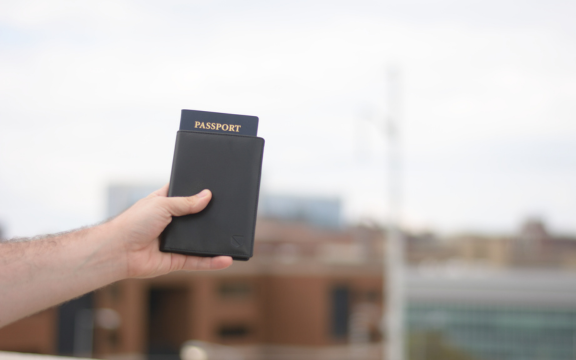Your Cart is Empty
Free Domestic Shipping on Orders Over $200
Free Domestic Shipping on Orders Over $200
Why You Should Protect Your Passport When Traveling
April 02, 2024 4 min read

Traveling internationally can be an exciting adventure full of new experiences. But before you embark on your journey, it’s important to protect one critical item - your passport.
Your passport contains sensitive personal information that could be used for identity theft or other crimes if it falls into the wrong hands. Read on to learn what’s actually inside your passport, what can happen if that data is compromised, real-world examples of passport data theft, and how to safeguard your passport while traveling.
What’s Actually Inside Your Passport
A passport may seem like just a little booklet that allows you to cross borders. But it contains:
- Your full legal name
- Date and place of birth
- Biometrics
- Passport number
- Issuing country
- Expiration date
- Physical description - height, hair, and eye color
- Photograph
- Signature
- RFID chip with your biometric data
With all this personal information concentrated in one place, a passport represents an attractive target. The embedded RFID chip is particularly vulnerable, as it can potentially be skimmed and cloned by attackers using readily available equipment.
Dangers of Compromised Passport Data
A passport is more than just a ticket to cross borders; it's a repository of personal information that, if fallen into the wrong hands, can lead to devastating consequences.
With the wealth of personal data inside your passport, attackers could use your information to:
- Open fraudulent credit cards or bank accounts
- Access existing accounts you hold
- File false tax returns to collect refunds
- Commit medical or insurance fraud under your name
- Obtain driver’s licenses or ID cards in your name
Additionally, passport data contains information that could help criminals locate your home address or track your movements. It’s critical to keep who has access to your passport data limited.
Real-World Examples of Passport Data Theft
Data breaches at companies and organizations that hold sensitive customer information, such as airlines, travel companies, and hotels, are common targets for attackers. These breaches can lead to the exposure of passport details, which can then be used for various fraudulent activities, including accessing bank accounts, opening fraudulent bank accounts, mining for more personal data, and committing believable passport forgeries.
The exposure of passport numbers, even without the physical document, can be significant. For example, in theMarriott data breach of 2018,approximately 500 million customer’s data was exposed, including up to five million passport numbers.
With additional personal details, attackers can create a comprehensive identity profile, which can be used for identity theft or to make forgeries appear more authentic.
How to Protect Your Passport While Traveling
Protecting your passport details is crucial both online and offline to prevent identity theft and unauthorized access to your personal information. Here are comprehensive strategies to safeguard your passport data:
Online Protection
- Be Cautious with Online Forms: When applying for visas or travel-related services online, ensure the website is secure and reputable. Look for “https://” in the URL and a padlock symbol in the address bar.
- Secure Digital Copies: If you store digital copies of your passport on your phone or cloud storage, ensure these platforms have strong passwords and, if available, enable two-factor authentication. This adds an extra layer of security against unauthorized access.
- Beware of Phishing Scams: Be vigilant about emails or messages requesting your passport details. Verify the sender’s authenticity before sharing any information. Phishing scams often mimic legitimate organizations to steal personal data.
- Use Trusted Services: When using services that require passport information, such as booking flights or hotels, ensure they are trusted and have robust privacy policies to protect your data.
Offline Protection
- Physical Security: Always keep your passport on your person in a secure manner, such as in a hidden travel pouch. Avoid leaving anywhere where it could be easily stolen.
- Photocopies and Digital Scans: Keep photocopies of your passport and travel documents in separate locations from your actual passport. Additionally, store digital scans in a secure online storage as a backup. This can be invaluable in obtaining an emergency travel document if your passport is lost or stolen.
- Discretion: Be mindful of your surroundings and who you share your passport information with. Limit exposure of your passport to potential onlookers and only provide it to officials or verified personnel when necessary.
- Report Loss or Theft Immediately: If your passport is lost or stolen, report it to the local authorities and your country’s embassy or consulate as soon as possible. This can help prevent misuse of your passport and expedite the process of obtaining a replacement
- Enhanced Security with an RFID Blocking Passport Wallet: While e-passports with RFID chips were designed to enhance security, they also introduce new vulnerabilities that travelers should be aware of. Security researchers have demonstrated the ability to “skim” or wirelessly read the data stored on the RFID chips in e-passports without the holder’s knowledge.
While clear evidence of widespread “in the wild” RFID skimming attacks on passports compared to credit cards is limited, the threat is plausible enough that taking precautions is highly advisable as researchers continue analyzing this technology, new attack vectors may be uncovered over time.
Opting for a high-quality RFID-blocking passport wallet, such asSLNT®s Passport Wallet, not onlysecures your passport information but also provides compartments for other essential travel items like boarding passes and credit cards. This ensures comprehensive protection for your travel essentials, keeping your personal information secure and giving you peace of mind during your journeys.
By implementing these online and offline protection strategies, you can significantly reduce the risk of passport data theft and travel with greater peace of mind.
Conclusion
Protecting your passport is critical when traveling internationally to safeguard your personal information and identity. Both online and offline precautions should be taken, such as being cautious when entering details into forms, securing digital copies, avoiding phishing scams, and always keeping your passport on your person or in a secure location. Reporting loss or theft immediately and keeping photocopies in separate locations can also prove invaluable. Opting for an RFID-blocking passport wallet adds an extra layer of security by protecting the sensitive information stored on your passport’s chip. Implementing comprehensive protection allows you to travel with confidence knowing your data remains secure.






